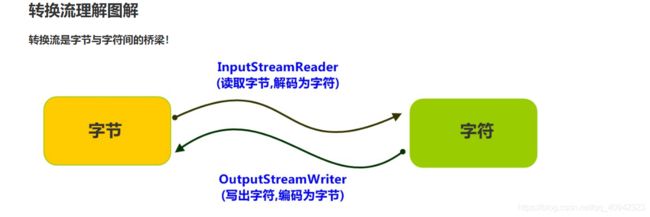java中的缓冲流,转换流,序列化流
缓冲流
缓冲流,也叫高效流,是对4个基本的FileXxx 流的增强,所以也是4个流,按照数据类型分类:
- 字节缓冲流:BufferedInputStream,BufferedOutputStream
- 字符缓冲流:BufferedReader,BufferedWriter
缓冲流的基本原理,是在创建流对象时,会创建一个内置的默认大小的缓冲区数组,通过缓冲区读写,减少系统IO次数,从而提高读写的效率。
字节缓冲流:
// 创建字节缓冲输入流
BufferedInputStream bis = new BufferedInputStream(new FileInputStream("bis.txt"));
// 创建字节缓冲输出流
BufferedOutputStream bos = new BufferedOutputStream(new FileOutputStream("bos.txt"));
public class BufferedDemo {
public static void main(String[] args) throws FileNotFoundException {
// 记录开始时间
long start = System.currentTimeMillis();
// 创建流对象
try (
BufferedInputStream bis = new BufferedInputStream(new FileInputStream("jdk9.exe"));
BufferedOutputStream bos = new BufferedOutputStream(new FileOutputStream("copy.exe"));
){
// 读写数据
int len;
byte[] bytes = new byte[8*1024];
while ((len = bis.read(bytes)) != -1) {
bos.write(bytes, 0 , len);
}
} catch (IOException e) {
e.printStackTrace();
}
// 记录结束时间
long end = System.currentTimeMillis();
System.out.println("缓冲流使用数组复制时间:"+(end - start)+" 毫秒");
}
}
字符缓冲流:
// 创建字符缓冲输入流
BufferedReader br = new BufferedReader(new FileReader("br.txt"));
// 创建字符缓冲输出流
BufferedWriter bw = new BufferedWriter(new FileWriter("bw.txt"));
特有方法:
- BufferedReader:public String readLine(): 读一行文字。
- BufferedWriter:public void newLine(): 写一行行分隔符,由系统属性定义符号。
public class BufferedReaderDemo {
public static void main(String[] args) throws IOException {
// 创建流对象
BufferedReader br = new BufferedReader(new FileReader("in.txt"));
// 定义字符串,保存读取的一行文字
String line = null;
// 循环读取,读取到最后返回null
while ((line = br.readLine())!=null) {
System.out.print(line);
System.out.println("------");
}
// 释放资源
br.close();
}
}
public class BufferedWriterDemo throws IOException {
public static void main(String[] args) throws IOException {
// 创建流对象
BufferedWriter bw = new BufferedWriter(new FileWriter("out.txt"));
// 写出数据
bw.write("黑马");
// 写出换行
bw.newLine();
bw.write("程序");
bw.newLine();
bw.write("员");
bw.newLine();
// 释放资源
bw.close();
}
}
输出效果:
黑马
程序
员
转换流
字符编码
计算机中储存的信息都是用二进制数表示的,而我们在屏幕上看到的数字、英文、标点符号、汉字等字符是二进制数转换之后的结果。按照某种规则,将字符存储到计算机中,称为编码 。反之,将存储在计算机中的二进制数按照某种规则解析显示出来,称为解码 。比如说,按照A规则存储,同样按照A规则解析,那么就能显示正确的文本符号。反之,按照A规则存储,再按照B规则解析,就会导致乱码现象。
编码:字符(能看懂的)–字节(看不懂的)
解码:字节(看不懂的)–>字符(能看懂的)
- 字符编码Character Encoding : 就是一套自然语言的字符与二进制数之间的对应规则。
编码表:生活中文字和计算机中二进制的对应规则
InputStreamReader类
转换流java.io.InputStreamReader,是Reader的子类,是从字节流到字符流的桥梁。它读取字节,并使用指定的字符集将其解码为字符。它的字符集可以由名称指定,也可以接受平台的默认字符集。
//创建一个使用默认字符集的字符流。
InputStreamReader isr = new InputStreamReader(new FileInputStream("in.txt"));
//创建一个指定字符集的字符流。
InputStreamReader isr2 = new InputStreamReader(new FileInputStream("in.txt") , "GBK");
OutputStreamWriter类
转换流java.io.OutputStreamWriter ,是Writer的子类,是从字符流到字节流的桥梁。使用指定的字符集将字符编码为字节。它的字符集可以由名称指定,也可以接受平台的默认字符集。
//创建一个使用默认字符集的字符流。
OutputStreamWriter isr = new OutputStreamWriter(new FileOutputStream("out.txt"));
// 创建一个指定字符集的字符流。
OutputStreamWriter isr2 = new OutputStreamWriter(new FileOutputStream("out.txt") , "GBK");
序列化
Java 提供了一种对象序列化的机制。用一个字节序列可以表示一个对象,该字节序列包含该对象的数据、对象的类型和对象中存储的属性等信息。字节序列写出到文件之后,相当于文件中持久保存了一个对象的信息。
反之,该字节序列还可以从文件中读取回来,重构对象,对它进行反序列化。对象的数据、对象的类型和对象中存储的数据信息,都可以用来在内存中创建对象。看图理解序列化:
ObjectOutputStream类
java.io.ObjectOutputStream 类,将Java对象的原始数据类型写出到文件,实现对象的持久存储。
public ObjectOutputStream(OutputStream out): 创建一个指定OutputStream的ObjectOutputStream。
FileOutputStream fileOut = new FileOutputStream("employee.txt");
ObjectOutputStream out = new ObjectOutputStream(fileOut);
序列化满足的操作
- 该类必须实现java.io.Serializable 接口,Serializable 是一个标记接口,不实现此接口的类将不会使任何状态序列化或反序列化,会抛出NotSerializableException 。
- 该类的所有属性必须是可序列化的。如果有一个属性不需要可序列化的,则该属性必须注明是瞬态的,使用transient 关键字修饰。
public class Employee implements java.io.Serializable {
public String name;
public String address;
public transient int age; // transient瞬态修饰成员,不会被序列化
public void addressCheck() {
System.out.println("Address check : " + name + " -- " + address);
}
}
public class SerializeDemo{
public static void main(String [] args) {
Employee e = new Employee();
e.name = "zhangsan";
e.address = "beiqinglu";
e.age = 20;
try {
// 创建序列化流对象
ObjectOutputStream out = new ObjectOutputStream(new FileOutputStream("employee.txt"));
// 写出对象
out.writeObject(e);
// 释放资源
out.close();
fileOut.close();
System.out.println("Serialized data is saved"); // 姓名,地址被序列化,年龄没有被序列化。
} catch(IOException i) {
i.printStackTrace();
}
}
}
输出结果:
Serialized data is saved
ObjectInputStream类
ObjectInputStream反序列化流,将之前使用ObjectOutputStream序列化的原始数据恢复为对象。
反序列化1
public class DeserializeDemo {
public static void main(String [] args) {
Employee e = null;
try {
// 创建反序列化流
FileInputStream fileIn = new FileInputStream("employee.txt");
ObjectInputStream in = new ObjectInputStream(fileIn);
// 读取一个对象
e = (Employee) in.readObject();
// 释放资源
in.close();
fileIn.close();
}catch(IOException i) {
// 捕获其他异常
i.printStackTrace();
return;
}catch(ClassNotFoundException c) {
// 捕获类找不到异常
System.out.println("Employee class not found");
c.printStackTrace();
return;
}
// 无异常,直接打印输出
System.out.println("Name: " + e.name); // zhangsan
System.out.println("Address: " + e.address); // beiqinglu
System.out.println("age: " + e.age); // 0
}
}
对于JVM可以反序列化对象,它必须是能够找到class文件的类。如果找不到该类的class文件,则抛出一个 ClassNotFoundException 异常。
反序列化2
另外,当JVM反序列化对象时,能找到class文件,但是class文件在序列化对象之后发生了修改,那么反序列化操作也会失败,抛出一个InvalidClassException异常。发生这个异常的原因如下:
- 该类的序列版本号与从流中读取的类描述符的版本号不匹配
- 该类包含未知数据类型
- 该类没有可访问的无参数构造方法
Serializable 接口给需要序列化的类,提供了一个序列版本号。serialVersionUID 该版本号的目的在于验证序列化的对象和对应类是否版本匹配。
public class Employee implements java.io.Serializable {
// 加入序列版本号
private static final long serialVersionUID = 1L;
public String name;
public String address;
// 添加新的属性 ,重新编译, 可以反序列化,该属性赋为默认值.
public int eid;
public void addressCheck() {
System.out.println("Address check : " + name + " -- " + address);
}
}

